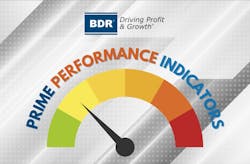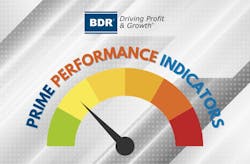Prime Performance Indicators Help Business Owners Achieve True Success
Successful business owners don’t just measure their company’s performance compared to their competitors. They also measure how well their business performs relative to all the available opportunities. In other words, success isn’t just about doing better than another company. It’s about performing up to your potential and achieving everything that’s possible.
To do that, business owners need to plan and identify the indicators that help them measure where they are and what they can achieve. We call these “Prime” Performance Indicators (PPIs) to reflect the prime, or most flourishing stage or state a company can reach.
Planning for What’s Possible
When a contractor creates a business plan, they look at where they are now and what is possible. Once an opportunity is identified, a key goal is established, along with an implementation plan for achieving the goal. The results can impact many areas of the business, but ultimately the goal is to increase net profit from operations, which will convert to cash, which then funds the company’s future growth.Because the amount of data can seem overwhelming, business owners may not know where to start. Every company has unique circumstances, and every business leader has priorities.
There are many PPIs to track, including:
- Productivity: The skilled trades industries have been facing a labor shortage for years, which is expected to worsen. Since skilled tradespeople drive revenue, measuring their efficiency effectively is critical. Most businesses operate at around 40% efficiency. That means they’re getting about 3.2 productive hours out of every eight-hour workday. Monitoring efficiency in order to reach 100% productivity is a key prime indicator for every company.
- Gross profit employee: It seems everyone is measuring revenue per employee, but that doesn’t tell the whole story. You may lose some opportunities if you have a high revenue per employee and a low gross profit per employee. This number reflects the company’s operational effectiveness.
Since skilled tradespeople drive revenue, measuring their efficiency effectively is critical.
Offering accessories to customers is a sure way to increase gross profit dollars earned on a job without impacting overheads. To achieve prime, a contractor must offer accessories and track the number of units sold. If the average gross profit on an accessory was $200, and you sold five a day, you increased the day’s net profit by $1,000, or $22,000 for the month. A business owner must determine which PPIs they will gain the most leverage against and establish a system to measure those and a cadence that keeps the information front and center.
How to Measure Success
Your company’s profit and loss statement is the most important tool for measuring the PPIs you choose to focus on.
When properly accounted for, the profit and loss statement serves as an unbiased record of operations. It’s your PPI scorecard. If profit margins aren’t in line with pricing, you should regard that as a yellow flag. Once it’s been thrown, it’s time to dig into your figures to determine why you missed your targets.
Think of the calendar like a ball game. We play 12 games a year, with 52 innings and 260 bats. Your profit and loss statement is the final scorecard. Daily and weekly reporting will tell you if you need to make any adjustments during the season to get a winning record.
Every system should have checks and balances or a system of reconciliation. When it comes to your financial reporting, the accounting team should follow a month-end close process and checklist. This process ensures the accuracy of the financial statements. Ultimately, financials are the unbiased judge of success. But this is only true if the accounting team follows a verifiable month-end close procedure.
A Path to Financial Freedom
PPIs tell us where we are today. During the planning process, we look at the opportunity — what is possible. If there is a disparity between where we are today and the opportunity available, we can build an actionable plan to bridge the gap between the two.
Business is a sport, and it should be fun! Step back and assess your game plan if you are not having fun in the business. What do you want to achieve personally and financially? Is your company delivering? Are there opportunities that you are missing? Planning using your PPIs will uncover your potential and provide a pathway to achieving financial freedom.
Kim Archer is vice president of coaching and trainer with Business Development Resources (BDR), a leading business training and coaching provider to HVAC contractors and distributors. More than 1,000 industry professionals attend BDR’s Profit Launch Business Planning workshop every year. The three-day event helps contractors build a detailed, five-year business plan that guides their company to new profit and growth levels. For more information, visit www.bdrco.com.
About the Author
Kim Archer
Vice President, Coaching
Kim Archer is Vice President of Coaching and Trainer with Business Development Resources (BDR), the premier provider of business training and coaching to HVAC contractors and distributors, established in 1998. BDR’s Profit Coach program has a membership of 600 leading contractors. Ten thousand HVAC professionals across North America attend BDR training courses annually. Nearly 1,000 industry professionals attend Profit Launch, BDR’s planning workshop. For more information, visit www.bdrco.com.

